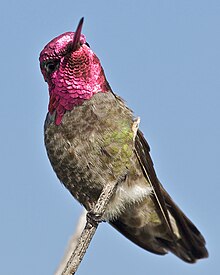
Hummingbirds are birds native to the Americas and comprise the biological family Trochilidae. With approximately 366 species and 113 genera, they occur from Alaska to Tierra del Fuego, but most species are found in Central and South America. As of 2024, 21 hummingbird species are listed as endangered or critically endangered, with numerous species declining in population.

The rufous hummingbird is a small hummingbird, about 8 cm (3 in) long with a long, straight and slender bill. These birds are known for their extraordinary flight skills, flying 3,200 kilometres during their migratory transits. It is one of nine species in the genus Selasphorus.

Sunbirds and spiderhunters make up the family Nectariniidae of passerine birds. They are small, slender passerines from the Old World, usually with downward-curved bills. Many are brightly coloured, often with iridescent feathers, particularly in the males. Many species also have especially long tail feathers. Their range extends through most of Africa to the Middle East, South Asia, South-east Asia and southern China, to Indonesia, New Guinea and northern Australia. Species diversity is highest in equatorial regions.

The ruby-throated hummingbird is a species of hummingbird that generally spends the winter in Central America, Mexico, and Florida, and migrates to Canada and other parts of Eastern North America for the summer to breed. It is the most common hummingbird in eastern North America, having population estimates of about 35 million in 2021.

The black-chinned hummingbird is a hummingbird occupying a broad range of habitats. Its summer range is in the western United States and southwestern Canada. It is migratory, wintering as far south as Mexico. In sunlight, the gorget of iridescent purple feathers bordering its black chin is noticeable.

Iridescence is the phenomenon of certain surfaces that appear gradually to change colour as the angle of view or the angle of illumination changes. Iridescence is caused by wave interference of light in microstructures or thin films. Examples of iridescence include soap bubbles, feathers, butterfly wings and seashell nacre, and minerals such as opal. Pearlescence is a related effect where some or most of the reflected light is white. The term pearlescent is used to describe certain paint finishes, usually in the automotive industry, which actually produce iridescent effects.

The calliope hummingbird is the smallest bird native to the United States and Canada. It has a western breeding range mainly from California to British Columbia, and migrates to the Southwestern United States, Mexico, and Central America for its wintering grounds. The calliope hummingbird is the smallest known long-distance bird migrant, completing migrations twice per year of some 9,000 km (5,600 mi).

The bee hummingbird, zunzuncito or Helena hummingbird is a species of hummingbird, native to the island of Cuba in the Caribbean. It is the smallest known bird. The bee hummingbird feeds on nectar of flowers and bugs found in Cuba.
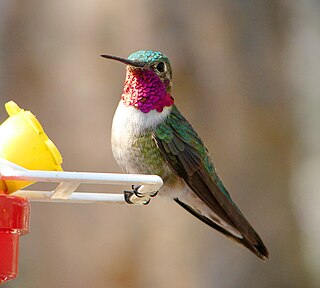
The broad-tailed hummingbird is a medium-sized hummingbird species found in highland regions from western United States and Western Canada to Mexico and Guatemala.
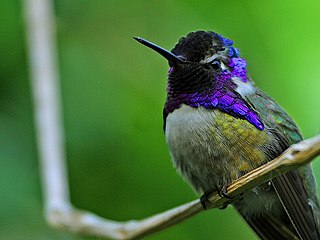
Costa's hummingbird is a bird species in the hummingbird family Trochilidae. It breeds in the arid region of the southwest United States and northwest Mexico; it winters in western Mexico.

Allen's hummingbird is a species of hummingbird that breeds in the western United States. It is one of seven species in the genus Selasphorus.

The blue-throated mountaingem, also known as the blue-throated mountain-gem or blue-throated hummingbird is a species of hummingbird in tribe Lampornithini of subfamily Trochilinae. It is found in the United States and Mexico.
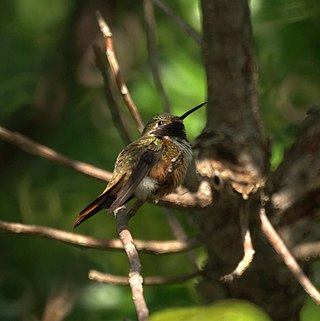
The Bahama woodstar or Bahama hummingbird is a species of hummingbird endemic to the Lucayan archipelago, including the Bahamian and Turks and Caicos islands. It is named the "hummer" by locals due to a distinct humming sound it makes while feeding.

The lucifer sheartail or lucifer hummingbird is a medium-sized, 10 cm long, green hummingbird with a slightly curved bill and distinctive outward flare of its gorget feathers. Its habitat is in high-altitude areas of northern Mexico and southwestern United States. It winters in central Mexico.

The broad-billed hummingbird is a small-sized hummingbird that resides in Mexico and the southwestern United States. Males and females have different features. The juveniles resemble the female adult more than the male adult. The broad-billed hummingbird is a bright coloured bird with a broad and bright red bill. The bird is also known for its other common names – the Colibrí Pico Ancho in Spanish and Colibri circé in French. It is more active during the day and less active during the night.

Xantus's hummingbird, previously known as the black-fronted hummingbird, is a species in the "emeralds", tribe Trochilini of subfamily Trochilinae. It is endemic to the Baja California Peninsula.

The hooded visorbearer is a small species of hummingbird in the family Trochilidae. Endemic to the east Brazilian state of Bahia, it is found only at higher altitudes in the Chapada Diamantina region. The species is sexually dimorphic. The male is an iridescent bronzy-green overall, with black on his crown and the sides of his head. His forehead and throat are a glittering green shading to bluish-green at the lower edge and narrowly bordered by black. The female is bronzer, with a green crown and brown sides to her head. Her throat is less colorful than the male's, and she lacks iridescence on her forehead. Both sexes have crimson tails and a narrow white breast band, the male with a brilliantly iridescent golden-orange spot in the center, at the lower edge of his gorget.
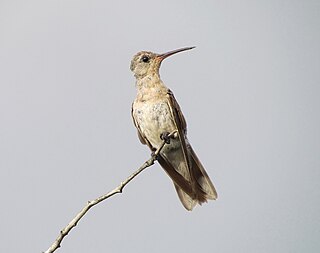
The buffy hummingbird is a species of bird in the hummingbird family Trochilidae. It is the only species placed in the genus Leucippus. This bird lives in dry forest and scrubland in northern South America where it feeds on insects and the nectar, flesh, and juice of cactus fruits.

The green-headed hillstar is a species of hummingbird found in the Andes of southern Ecuador and northern and central Peru. It is one of 6 species in the genus Oreotrochilus, and can be distinguished from its relatives by subtle differences in plumage coloration. The green-headed hillstar received its name due to its bronze and green crown and gorget of bright emerald green plumage. The species was first discovered by English ornithologist Osbert Salvin in 1895 and named after Polish ornithologist Jean Stanislaus Stolzmann.
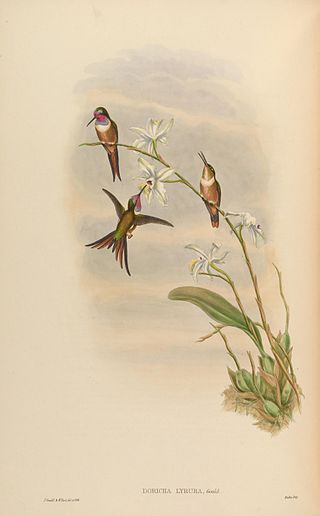
The Inagua woodstar, also called the lyre-tailed hummingbird, is a species of hummingbird in tribe Mellisugini of subfamily Trochilinae, the "bee hummingbirds". It is endemic to the two islands of the Inagua district of the Bahamas.




